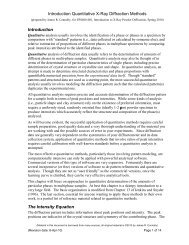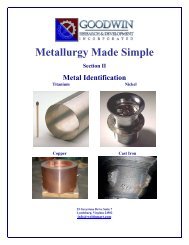Metallography and Microstructures of Cast Iron
Metallography and Microstructures of Cast Iron
Metallography and Microstructures of Cast Iron
You also want an ePaper? Increase the reach of your titles
YUMPU automatically turns print PDFs into web optimized ePapers that Google loves.
574 / <strong>Metallography</strong> <strong>and</strong> <strong>Microstructures</strong> <strong>of</strong> Ferrous AlloysFig. 36 Austempered ductile iron (Fe-3.6%C-2.5%Si-0.052%Mg-0.7%Cu). AF, acicular ferrite; A,austenite; <strong>and</strong> M, martensite. The casting was austemperedat 900 C (1650 F), held 2 h, taken to salt bath at 360 C(680 F), held 30 min, <strong>and</strong> air cooled. Etched with 4% nital.1000Fig. 38 Same as in Fig. 36 but after etching with 10%sodium metabisulfite. AF, acicular ferrite; A,austenite; <strong>and</strong> M, martensite. 1000amount <strong>of</strong> each constituent. In the case <strong>of</strong> theternary phosphorous eutectic, which consists <strong>of</strong>ferrite, cementite, <strong>and</strong> iron phosphide (Fe 3 P), nitaldoes not help in the identification <strong>of</strong> the constituents,nor does it provide enough informationabout distribution <strong>of</strong> the eutectic constituents.Figure 23 shows the microstructure <strong>of</strong> the ternaryphosphorous eutectic in gray iron after etchingin 4% nital. The white areas that surroundthe ternary eutectic <strong>and</strong> are also visible insidethe eutectic can be either ferrite or cementite.Figure 24 shows the microstructure <strong>of</strong> the samespecimen after selective color etching with hotASP (Table 2, etchant No. 4). Cementite in theeutectic is tinted brown <strong>and</strong> blue colors (also inpearlite), while ferrite <strong>and</strong> iron phosphide are nottinted. To reveal the ferrite, the same specimenwas etched with Klemm’s I reagent. Figure 25shows the eutectic regions with precipitates <strong>of</strong>brown ferrite (also in pearlite), while cementite<strong>and</strong> iron phosphide are not tinted.Murakami’s reagent (Table 2, etch No. 8),used at 50 C (120 F) for 3 min <strong>and</strong> containingpotassium hydroxide (KOH), potassium ferricyanide(K 3 Fe(CN) 6 ), <strong>and</strong> distilled water, can beused for revealing <strong>and</strong> estimating the amount <strong>of</strong>iron phosphide in steadite. Figure 26 shows thisconstituent <strong>of</strong> the ternary phosphorous eutecticmicrostructure, which was tinted a light-browncolor, while cementite <strong>and</strong> ferrite remained colorless.The microstructure <strong>of</strong> the same specimenafter overetching (5 min) with the same reagentis shown in Fig. 27. This time, cementite wasalso revealed <strong>and</strong> was tinted a yellow color,while ferrite remained white. The color <strong>of</strong> theiron phosphide changed to a dark-brown <strong>and</strong>gray-blue color. Nevertheless, extending theetching time beyond 3 min is not recommended,because this can falsify the true results <strong>of</strong> themicrostructural examination.Good differentiation <strong>of</strong> all constituents in theternary phosphorus eutectic can be obtained withBeraha’s reagent (Table 2, etch No. 9), a mixture<strong>of</strong> hydrochloric acid (HCl), selenic acidFig. 37 Same as in Fig. 36 but after etching with Beraha-Martensitereagent. AF, acicular ferrite; A,austenite; <strong>and</strong> M, martensite. 1000Fig. 39 White alloyed cast iron (Fe-3.4%C-0.92%Mn-1.89%Si-9.52%Cr-6.27%Ni). Etched with Beraha-Martensite.PM, plate martensite; FM, fine martensite;EC, eutectic carbides type M 7C 3; SC, secondary carbides;<strong>and</strong> MS, manganese sulfite. The casting was heat treated:austenitized at 750 C (1380 F), held 2 h, <strong>and</strong> air cooled;tempered at 250 C (480 F), held 4 h, <strong>and</strong> air cooled.1300 (microscopic magnification 1000)Fig. 40 Same white iron as in Fig. 39 but after etchingwith 4% nital. M, martensite; EC, eutectic carbides;<strong>and</strong> SC, secondary carbides. 1300 (microscopicmagnification 1000)








